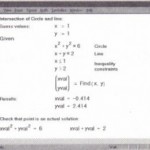

This function is useful when find fails to find a solution. The minerr function uses the last iteration even if it falls outside of TOL. The find function iterates a solution until the difference in the two most recent iterations is less than TOL. You may want to use minerr if PTC Mathcad cannot iterate a solution. The minerr function is used in place of the find function in a solve block. Thus if a solve block constraint is x > 3, this constraint is satisfied if x > 2.9990. The CTOL (constraint tolerance) built-in variable tells PTC Mathcad how closely a constraint in a solve block must be met for a solution to be acceptable. This will increase the precision of the result, but it will also increase the calculation time, or may make it impossible for PTC Mathcad to arrive at a solution. If you are not satisfied with the solutions arrived at, you can redefine TOL to be a smaller number. When the difference between the two most recent iterations is less than TOL (convergence tolerance), PTC Mathcad arrives at a solution. When using solve blocks and the root function, PTC Mathcad iterates a solution. The values can also be redefined within the worksheet. The values of a and b must meet these requirements: a Worksheet Settings>TOL). If they are specified (bracketed), root finds var on this interval. It returns the value of var to make the function f equal to zero. The root function takes the form root(f(var), var, ). Because of this, it is helpful to plot the function prior to giving PTC Mathcad the initial guess. If a function has several solutions, then the solution that PTC Mathcad finds is based on the initial guess you give PTC Mathcad. For now, we will focus on using the root function. We will also discuss solving multiple equations with multiple unknowns. In later sections, we will discuss finding all the solutions to a polynomial function. Root Function The root function is used to find a single solution to a single function with a single unknown. Provide several engineering examples which illustrate the use of each method of solving equations.Įssential PTCÒ Mathcad PrimeÒ 3.0.
POLYROOTS MATHCAD HOW TO
Illustrate how to use units in solving equations. Show how to use a solve block using find, maximize, and minimize to solve multiple equations with multiple unknowns. Show how a plot is useful to determine the initial guess. Discuss the two different forms that it takes: unbracketed and bracketed. Some of the functions discussed require initial guess values, thus a plot is useful to help select the initial guess.

This helps to visualize the solution before using PTC Mathcad to solve the equations. As discussed in Chapter 8, when trying to solve for an equation, it is very useful to plot the equations. Because these are some of the most useful functions for engineers, this chapter will use many examples to illustrate their use.

The intent of this chapter is to illustrate how engineering problems can be solved using the PTC Mathcad functions root, polyroots, and Find. In this chapter, we will add more solving tools to your PTC Mathcad toolbox. In Chapter 10, we introduced the keyword “solve” with the symbolic evaluation operator. It ranks up there with the use of units as one of PTC Mathcad’s best features. Solving engineering equations is one of PTC Mathcad’s most useful power tools.


 0 kommentar(er)
0 kommentar(er)
